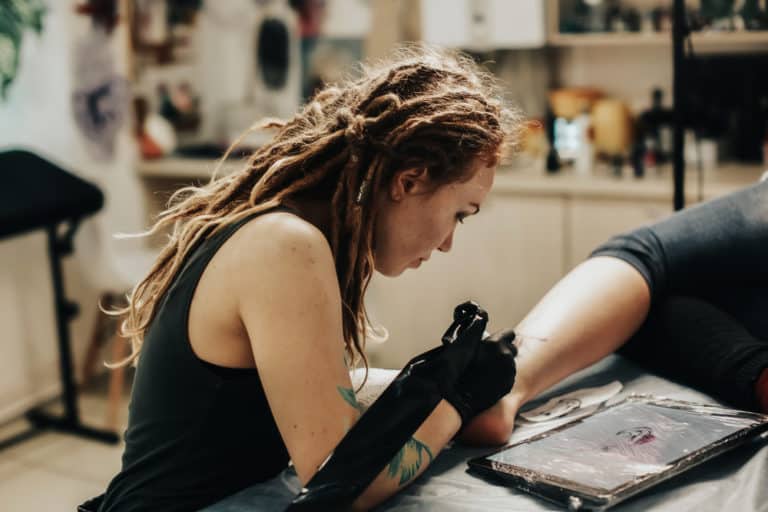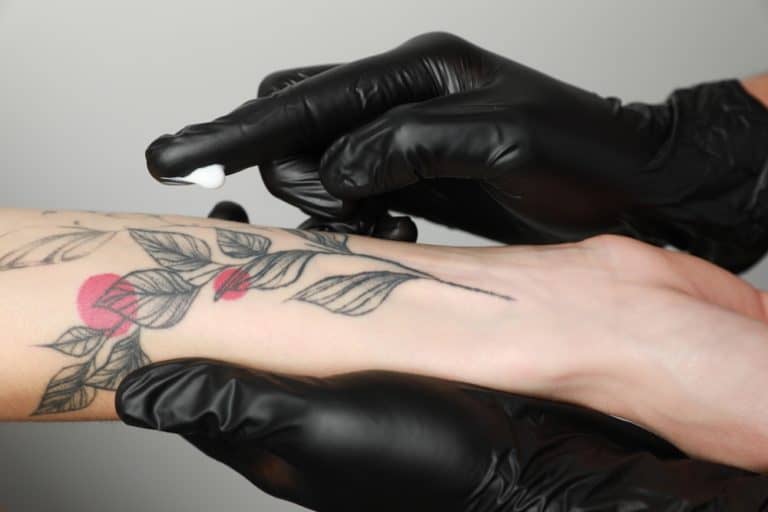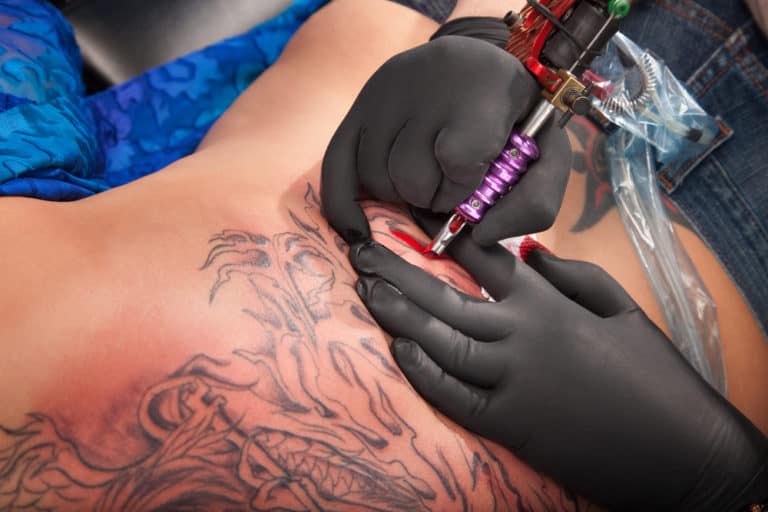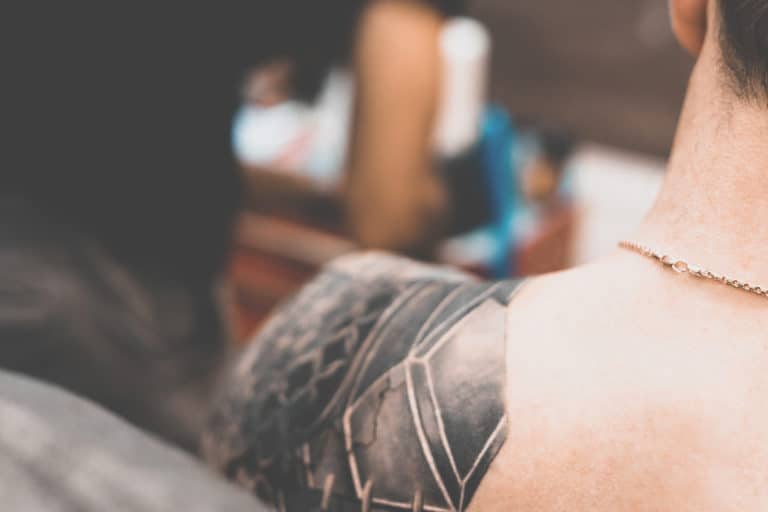How Long Does Tattoo Removal Take To Heal?
Tattoos are a serious commitment, but they sometimes lose their initial meaning, or we regret them altogether. You are not alone in this, as between 15 and 20 percent of people opt to get their tattoos removed. If you have started the removal process or are considering undergoing it, you are likely wondering what the recovery time is.
After laser treatment sessions, the time to heal sits between 4 and 8 weeks. Healing depends on the type of treatment chosen, your overall state of health, as well as how diligently you adhere to your aftercare instructions. There will be numerous sessions, and it is vital to take care of the area.
Your options are surgical removal, dermabrasion, and the safest and most proven method is laser treatment. Assuming you have gone with the laser option, post-treatment care is just as crucial. Things like hydrating and self-care will help speed up the process, so be sure to read on for more info.
The Timeframe For Tattoo Removal To Heal
Without a doubt, laser treatment is the most effective means of ridding yourself of unwanted ink. The first session took place in 1967, so this has been around for a while, but the process has evolved. More and more people who do not want their tattoos are trusting in this method.
It is estimated that approximately 15 to 20 percent of people decide to have their supposedly permanent tattoos removed. What is interesting about the process is that each session typically only takes a few minutes; this is obviously dependant on the size of the artwork, though.
Although the treatment is quick and relatively painless, the recovery process following each removal session is substantially longer. Immediately following the treatment, the first thing you will experience is something known as ‘frosting’ as the area turns a whitish hue. This typically only lasts between 5 and 10 minutes.
This is no cause for concern and is entirely normal; however, you need to have it checked if it persists and does not subside. You will likely experience redness, swelling, itching, pain, discomfort, and potentially blistering after the treatment. These symptoms should subside after about a week or so.
If you find that the aftereffects are too bothersome or persist for more than a few days, you can take acetaminophen (paracetamol). We do, however, advise against aspirin. This is because aspirin thins one’s blood and can result in bleeding, bruising, or even scarring.
Your skin will continue to feel sensitive for roughly another week, and you may experience a sunburn-like sensation. To alleviate this, you can use an ice pack to help soothe the skin, and anti-cortisol ointments can be applied to aid in easing any discomfort. After 2 weeks, all initial responses should have subsided.
You should fully recover from the procedure in 4 to 6 weeks; however, there are cases where it can take as long as 8 weeks. If it takes longer, this may well be a sign of skin fatigue, which is an issue that people experience on occasion. One of the main factors leading to this is not providing ample time to heal between sessions.
This also means your body’s capabilities to effectively remove the ink declines. That is why it is essential to give enough time between sessions (with some technicians advising periods of up to 3 months). Additionally, your health and immune system’s efficiency play a vital role in the rate of ink elimination and recovery.
How Does Laser Tattoo Removal Work?
In summary, the process involves using a laser to unobtrusively break down the ink of the tattoo so that your body can then flush it out.
Since you first applied the tattoo to your skin, your body has been trying to remove it. This is because the ink is a foreign body and your cells recognize that it does not belong there. However, the particles are between 100 and 200 nanometers in size, and this is far too large for your macrophages (a type of white blood cell) to process.
These cells are capable of absorbing the ink, but once this has happened, they cannot release it. If, for some reason, a macrophage containing tattoo ink ruptures, the surrounding macrophages will absorb it. This is why tattoos will remain in your skin permanently until you seek cosmetic treatment.
The laser targets the particles of the tattoo, and they absorb this energy that is focused on them. Resultantly, they burst, but the surrounding tissue is unaffected by this. Once the ink particles have been broken into small fragments by the laser, your body is then able to handle them and begin expelling them.
Your white blood cells then take over and carry these ink remnants into your lymphatic system. Following this, most of the waste will be expelled via the digestive system, while some may depart through urine or sweat. This process, along with the healing, takes time and is why the sessions are spaced so far apart.
How Long Does It Take To See Results Though?
This will depend on a few factors. Such as: how well your body responds to the laser treatment, the type and colors of ink used, the pigmentation of your skin, and your overall health. One thing is for sure, though: the process will span over multiple sessions.
These sessions are usually scheduled for every 6 to 8 weeks, but the period may be extended if your skin requires more time to heal from the treatment. After about the third appointment, you should start to observe a noticeable difference, which will be after roughly 5 to 6 months.
The overall timeline for the complete removal of your tattoo will vary depending on the factors mentioned. However, typically people require between 6 and 10 sessions until the tattoo can no longer be seen. There are outlying cases, though, where some people have only needed 4 and others up to 14 or 15.
Accounting for the time between appointments, you can expect the entire process to take 1 to 2 years. It is important to have clear expectations upfront, so you do not become disillusioned by the potentially long wait. Take heart, though, in that each session will present gradual progression until the body art is gone for good.
Caring For Your Skin After The Treatment
Just as tattoos can be applied to any part of the body, they can also be removed. Regardless of where it is located, though, you need to follow the post-treatment instructions to a tee.
The skin should be covered in a layer of antibiotic healing ointment (or whatever is prescribed) and bandaged with sterile gauze for at least a few days, but preferably the first week. Do not apply any other creams or cover the area with makeup for no less than a week.
Following this, you can remove the bandage, but be sure to keep the area dry and clean. In the event of the skin experiencing itching, swelling, or irritation, you may wish to apply hydrocortisone cream. This also helps moisturize the area while it heals. In the event of unwanted side effects, stop use immediately.
Vitamin E ointment is also worth getting and applying to the affected area, regardless of whether you are suffering from irritation, as it aids in the restoration of damaged skin cells.
If you experience severe itchiness or notice that the skin is secreting discharge, this indicates that there is likely an infection, and you should consult a doctor. You should also book an appointment if overall discomfort persists for more than 2 weeks, as this is potentially a cause for concern.
Showering After Tattoo Removal Treatment
It is strongly advised that you do not shower, or apply water to the treated area for at least 2 to 3 hours following the session, especially after your first treatment. You can shower after removing the bandage, but use mild soap, avoid high-pressure water, and pat dry the treated area.
It is also highly recommended not to soak the affected area until the skin has healed completely. This means that one should refrain from sitting in a sauna, using a hot tub, or going swimming. This is because you will have an increased chance of infection.
On top of this, we suggest that activities that cause excessive sweating should be avoided for at least the first week following treatment. This is because sweat can soften newly formed scabs (which could tear) and increase the likelihood of infection.
Avoiding And Protecting Yourself From The Sun
Following laser treatment, you do not need to stay out of the sun entirely; however, it is paramount to keep the treated area covered. If you get sunburnt, not only will it mean that you might have to postpone your next appointment, it could cause significant damage to skin that is highly sensitive.
Just to be safe, it is advisable that if you go out in the sun, you should put on sunblock with at least an SPF of 25 (higher would be better). This is because sunburn is the worst thing for your skin following laser removal.
Getting sunburn and damaging the skin on other parts of your body will lead to dehydration and resources, that your body should be using to heal the treated area, will have to be allocated to the burnt skin as well.
Burning or even tanning will slow the healing process down and ultimately delay matters. This means more time until the ink is completely removed. So stay covered and spend as little time as possible in the sun.
Refrain From Picking Scabs Or Popping Blisters
The presence of scabs and blisters is expected and highly likely to occur. This is your body’s way of healing the affected area and should be allowed to follow its natural process. These can get itchy and irritating, and the desire to pick or scratch them may be strong but show restraint.
Opening a wound or forcing blisters to burst not only prolongs the healing process but is also a sure-fire way to increase the chances of infection. It is thus highly suggested that you permit the scabs to fall off in their own time and allow blisters to drain naturally. This will also increase the likelihood of healing without scars.
Another point that must be brought up is that of shaving. Avoid using a razor on that particular part of your body and the surrounding area (as you do not want to open the wound accidentally).
Keeping Healthy Will Aid The Recovery Process
As we have touched on, your immune system plays a vital role in the rate at which tattoo removal occurs. People with stronger immune systems will find that their bodies expel the ink particles faster than others. Also, these individuals will discover their skin heals more rapidly, and they are less likely to experience infection.
People have different physical conditions, and some naturally have more robust immune systems. However, you can do things to promote your health, and you will only benefit that much more by doing so. Also, do remember the length of time this is going to take, so it is worthwhile making the following adjustments:
- Do not smoke, or if you are a smoker, try to reduce the number of cigarettes you smoke per day. This is because your body has to work to remove the toxins and pollutants caused by the smoke and, therefore, will not be as effective at healing you and ridding itself of the ink particles.
- Reduce your alcohol consumption, or if possible, avoid it entirely. Alcohol causes dehydration and can impact your liver and kidneys’ functionality. This will ultimately slow down the healing process and make it more difficult for your body to flush out the particles generated by the laser removal.
- Ensure that you are hydrated at all times. Giving your body enough water is an essential part of boosting your immunity. Water aids in flushing toxins out of your body and restores blood cells. It also assists your skin in retaining its elasticity and helps prevent scarring.
- Eat a balanced and nutrient-filled diet; this will be a big part, especially if you typically eat unhealthily. Eating correctly will help aid the healing process and improve your body’s efficiency and overall functionality. This will potentially also help to reduce the length of the process.
- Exercise is key to improving one’s health. It is recommended not to exercise the first week after the laser treatment, but it is undoubtedly encouraged after that. On top of improving your health, exercise also increases blood flow, which assists your body in expelling the particles.
Conclusion
It will be a while until you see results, and this time frame is affected by various factors, from the ink used to the strength of your immune system. On average, though, people require between 6 and 10 sessions until the tattoo is completely removed. The time it takes to heal between treatments is roughly 4 to 6 weeks.
Some people heal and see results quicker, and others require additional time to recover and more treatments. It is best to consult with the technician beforehand to gauge how long it will likely take. Finally, keeping healthy and following the post-treatment skincare advice will play a big part in the healing process.
Sources
- https://www.healthline.com/health/tattoo-removal-how#before-and-after
- https://removery.com/blog/tattoo-removal-healing/
- https://www.chronicinktattoo.com/blog/laser-tattoo-removal-healing-stages/
- https://dermatologyandlasergroup.com/can-expect-laser-tattoo-removal-healing-process/
- https://info.astanzalaser.com/blog/7-most-frequently-asked-questions-from-tattoo-removal-patients
- https://www.andreacatton.co.uk/2014/03/laser-tattoo-removal-healing-process/







